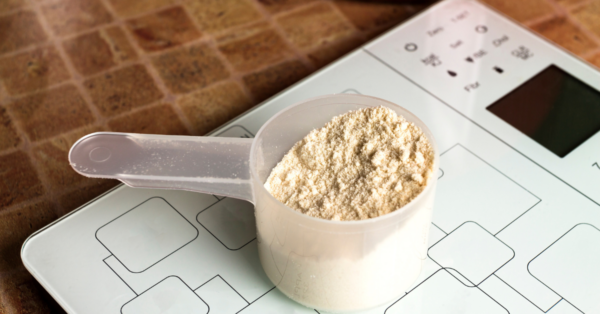Medically Reviewed by: Chris Duncombe, M.D.
Lactobacillus plantarum is one of the most widely studied bacterial strains in the Lactobacilli genus.
It is a Gram-positive, non-spore forming rod bacteria that is found in many strains in lactic acid fermented food products (1,2). Such foods as brined olives, pickles, sauerkraut, feta cheese, African ogi, cassava, and Asian kimchi contain the Lactobacillus plantarum bacterium strain.
Lactobacillus plantarum is a very adaptable strain that can be grown at temperatures ranging from 15 to 45 degrees Celsius and environments with a pH as low as 3.2 (1). Due to its high tolerance of such acidic environments, it can easily survive in the human gastrointestinal tract.
In addition, Lactobacillus plantarum can withstand the presence of bile salts in the gastrointestinal tract (3). These bile salts disperse and absorb fat in the gut and can disrupt the integrity of the cell membrane as well as generate free radicals that lead to oxidative stress.
However, these behaviors do not deter Lactobacillus plantarum, which can cope effectively under such stressful conditions in the gastrointestinal tract.
Origins
Lactobacillus plantarum has been isolated from a variety of hosts such as plants, the human gastrointestinal tract, animals such as poultry and insects, as well as a variety of foods such as meat, fish, vegetables, olives and raw or fermented dairy products (2,4).
Lactobacillus plantarum has been used as a starter culture in the fermentation of many foods such as (5,6):
• Yogurt with live and active cultures
• Raw, unpasteurized sauerkraut
• Pickles brined in water and sea salt
• Raw, aged cheese such as Swiss, provolone, Gouda, Cheddar, Edam, Gruyére, and cottage cheese
• Traditionally baked sourdough bread
• Kefir
• Tempeh, or fermented soybeans
There are a diverse array of lactobacillus plantarum strains the history and evolutionary lineage of which is not clear.
Potential health benefits
Many health benefits have been observed in connection with Lactobacillus plantarum.
Along with helping improve the composition of the gut microflora, this bacterium has been shown to have anti-inflammatory, anti-microbial, and immune-modulation properties. Its tolerance to harsh environments in the body also make it an effective treatment for digestive disorders and restoring gut microbiota.
Listed below are examples of the diverse range of applications that Lactobacillus plantarum has in the treatment of many aspects of health.
Antimicrobial and Anti-Inflammatory Properties
The antimicrobial properties of Lactobacillus plantarum can be beneficial to protect humans and their food supply from harmful bacterium that could cause illness.
Just as protective are the anti-inflammatory properties of lactobacillus plantarum strains that can help bring relief to those suffering from conditions such as those in the gastrointestinal tract.
Lactobacillus plantarum isolated from fermented olives has shown potential for this bacterium to act as an antimicrobial defense against Salmonella (4).
A further study of the relationship between Lactobacillus plantarum and Salmonella was conducted on newly hatched chicks either infected with Salmonella or not (7). This study showed that lactobacillus plantarum LTC-113 can protect their hosts from the disruption of the intestinal barrier function by Salmonella.
It does this by helping to regulate the expression of tight junction genes and inflammatory mediators, which in turn helps to decrease Salmonella colonization in the gut.
A similar mechanism was found to help remit symptoms in those with ulcerative colitis (UC) (8). This study looked at mice infected with dextran sodium sulfate (DSS)-induced ulcerative colitis and the impact of Lactobacillus plantarum treatment.
Those mice treated with a supplement containing lactobacillus plantarum ZDY2013 and bifidobacterium bifidum WBIN03 were found to down-regulate pro-inflammatory cytokines and upregulate antioxidant factors, in turn relieving UC symptoms.
The immune system is controlled by compounds called cytokines, which are essentially proteins made by cells in the body that affect the behavior of other cells, and in turn, help regulate the immune system (9). In this case, the lactobacillus plantarum bacterium helps to prevent the cytokines from eliciting an inflammatory response that could lead to UC symptoms.
Another study looked at the anti-inflammatory protein of lactobacillus plantarum known as Micro Integral Membrane Protein (MIMP) that was tested on a DSS-induced colitis model (10). MIMP was found to regulate the gut barrier, microbiota, and inflammatory cytokines in a cell culture model through its anti-inflammatory properties.
This study shows a potential use for MIMP to help those with inflammatory bowel disease, but more studies need to be done to help determine the exact mechanism of such anti-inflammatory properties.
Gut Health Protection from Pathogens
Besides reducing inflammation in the gut, Lactobacillus plantarum can also protect the gastrointestinal tract by stopping foreign organisms from producing disease. For example, Lactobacillus plantarum strain 299v creates an acidic environment in the GI tract, which in turn prevents growth of pathogens (11).
Because of these properties as well as through its anti-inflammatory properties, this strain has been found to ease abdominal symptoms in individuals with irritable bowel syndrome (12).
The mechanism of gut health protection provided by Lactobacillus plantarum is suggested to be a result of the bacteriocins produced by the bacterium. Bacteriocins are proteins produced by one strain of bacteria that work to act against those of a closely related strain. Plantaracin EF, a type of bacteriocin produced by wild-type lactobacillus plantarum NCIMB8826, is suggested to have a role in digestive health as seen in mice studies (13).
Enhanced Nutrient Bioavailability
By helping humans get more nutrition from the food they consume, lactobacillus plantarum can help improve quality of life and reduce disease risk. An example of this benefit can be seen in a study that showed lactobacillus plantarum L7 increased the nutrient levels, mineral bioavailability of a rice-fermented beverage (14).
The bacterium did this by increasing activity of the enzyme phytase, which helps liberate phosphate and mineral residues from the phytic acid found in various plants, seeds, and grains. This strain of lactobacillus plantarum also improves digestibility of this rice beverage by reducing starches and increasing its antioxidant capability.
Those with iron deficiency may benefit from the use of lactobacillus plantarum 299v to help improve iron absorption. Research has found that this bacterial strain can increase iron absorption by 50% in a drink that contained an already high iron bioavailability (15).
Immunomodulation Benefits
Maintaining the health of the immune system is vital to protecting the body from disease. Lactobacillus plantarum, as you will see in the studies below, have the potential to enhance the impact of the immune system in protecting the body from foreign organisms that can lead to disease.
The genotyping of Lactobacillus plantarum PS128, isolated from fu-tsai, or a fermented mustard product, has shown potential for this bacterium to positively affect the immune system (16).
Along these same lines, recent research has found that Lactobacillus plantarum may elicit specific immune responses after intranasal and oral administrations, which reveals potential for this bacterium to be used as a vaccine vector, such as acting as a carrier for tuberculosis antigens (17).
This bacterium may be used as a vaccine vector against dust mite allergies (18). Furthermore, there is potential that lactobacillus plantarum, in its heat-killed form, may be able to provide protection against influenza (19). This potential is revealed as a result of improved survival rates in those infected mice treated with the bacterium.
Cardiovascular Health Benefits
With heart disease being a leading cause of death among humans globally, it is reassuring to see that various strains of lactobacillus plantarum have the potential to reduce cardiovascular risk. For example, Lactobacillus plantarum strains TGCM 15, TGCM 26, TGCM 33, and TGCM 128 all exhibited cholesterol-lowering properties (20).
In addition, Lactobacillus plantarum ECGC 13110402 research reveals significant LDL cholesterol-lowering properties of this bacterial strain in normal to mildly hypercholesterolemic adults (21). Furthermore, Lactobacillus strain 299v has been shown to significantly lower LDL cholesterol and fibrinogen in healthy men and women (22).
This same study also observed a significant reduction in blood pressure in the active study group.
Another lactobacilllus plantarum strain, CUL66, was demonstrated to have cholesterol-lowering properties in wild-type mice, but will need further assessment in human studies before any confirmed cholesterol-lowering benefits in humans can be claimed (23). Furthermore, a meta-analysis of randomized controlled trials of lactobacillus bacterium strains found that lactobacillus plantarum can significantly reduce total cholesterol and LDL cholesterol in humans (24).
Improvement of Cognitive Health Factors
By improving the condition of the gut microbiome, lactobacillus plantarum has shown the potential to help improve cognitive health factors as well as mental health status.
A study of albino rats found that those D-Galactose-induced Alzheimer’s had improved cognitive function after treatment with lactobacillus plantarum MTCC1325 for 60 days (25).
Along these same lines, another mouse study demonstrated that lactobacillus plantarum C29 can prevent memory impairment by restoring the gut microbiota (26). These studies show a potential area of research to be done in human model studies.
Another study looked at the effects of lactobacillus plantarum MTCC 9510 supplementation on chronic mild stress-induced or sleep-deprived mice (27). The study results reported that treatment with the probiotic helped prevent stress-induced anxiety, depression, and memory-related behaviors as well as prevented oxidative stress markers and inflammatory cytokines.
Therefore, it is suggested that treatment with this strain of Lactobacillus plantarum has the potential for treating and preventing stress-induced pathology.
Obesity and Metabolic Disorder Treatment
With obesity being a risk factor of chronic diseases such as heart disease and diabetes, it is promising to see research that shows the potential for lactobacillus plantarum to improve obesity status in humans.
One such study involves mice fed a high-fat diet and looked at the impact of Lactobacillus plantarum Q180 on adipocyte size and differentiation (28).
The study results showed that after six weeks of treatment, this bacterium strain helped reduce adipocyte size and inhibited adipocyte differentiation and fat absorption. This study suggests that lactobacillus plantarum Q180 may be used to help improve obesity status in humans.
Another study looked at a lactobacillus plantarum Ln4 strain that was isolated from Napa cabbage kimchi (29).
Oral administration of this bacterium strain was performed on mice that were fed a high-fat diet. Study results show that this bacterium strain helped to reduce weight gain and lipid accumulation, and stimulated glucose uptake for energy. This study revealed the potential of lactobacillus plantarum Ln4 to be used in treatment of humans with metabolic disorders upon further study of this strain.
Finally, another study looked at high-fat and low-dose streptozotocin (STZ)-induced type 2 diabetes in rats (30). Rats were treated with Lactobacillus plantarum NCU116 and carrot juice fermented with the bacterium strain.
After five weeks of treatment, study results demonstrated that the carrot juice fermented with lactobacillus plantarum NCU116 lowered the risk of type 2 diabetes in the rats by helping to regulate blood glucose, hormones, and lipid metabolism. These results suggest that this lactobacillus plantarum strain may be applied to treatment of humans with diabetes upon further study.
Other potential applications of lactobacillus plantarum being studied are:
Vaginal Yeast Infection Treatment
Women with a history of vulvovaginal candidiasis were provided three treatments of lactobacillus plantarum P17630 in 15-day cycles each followed by a 15-day washout period (31). This study found that lactobacillus plantarum P17630 helped to improve the vagina colonization of lactic acid bacteria, and in turn suggests that this bacterium could be used as a possible treatment for vulvovaginal candidiasis.
Antiviral Therapy
Exopolysaccharides, which are high-molecular-weight polymers composed of sugar residues, secreted from lactobacillus plantarum LRCC5310, were studied in mice infected with rotavirus (32). The exopolysaccharides were shown to have an antiviral effect against the human rotavirus infected mice.
Treatment for Atopic Dermatitis
A dosage of 1010 colony forming units per day of lactobacillus plantarum IS-10506 was given to a small group of children with eczema, or atopic dermatitis.
Compared to the control group, which received placebo, the children in the probiotic group had significantly lower SCORAD or Scoring Atopic Dermatitis Index (33).
Larger and longer studies need to be done to confirm these potentially promising findings.
Antioxidant Therapy
A study of d-galactose-induced aging mice tested the effects of two strains of lactobacillus plantarum, CCFM10 and RS15-3 (34).
This study shows that the antioxidant ability of lactobacillus plantarum CCFM10 was higher than RS15-3. This study suggests that the antioxidant abilities of lactobacillus plantarum may depend on the strain of the bacterium.
Activation of Stem Cells
A study was done to observe the effect of lactobacillus plantarum IS-10506 treatment on the stem cells of mice exposed to E. coli lipopolysaccharide (35). Study results show that seven days of treatment with this strain of bacterium activated intestinal stem cells to help counter inflammation.
These results suggest that Lactobacillus plantarum IS-10506 may be useful in intestinal health treatment.
Food Production Treatment
A study of a food model examined the impact of lactobacillus plantarum LP 735 on vibrio parahaemolyticus BCRC (Bioresource Collection and Research Center) 10806 and BCRC 12865 (36).
Study results showed that lactobacillus plantarum LP 735 can inhibit inflammatory responses caused by the vibrio strain and can inhibit the growth of the strain in food products.
Another study looked at the effect of lactobacillus plantarum on Cabernet Gernischt wine (37). Lactobacillus plantarum helped lower sugar, reduced total acid, as well as reduced yellowness.
In addition, this bacterium significantly increased the concentration of pyranoanthocyanins in the wine, which means that the wine exhibited more anthocyanin-derived red wine pigments, which are a form of antioxidant.
Another application in food production is the ability of lactobacillus plantarum to degrade harmful tannins, which can form indigestible protein complexes and have been linked to toxicity of the liver as well as cancer (3). Lactobacillus plantarum WCFS1 has been found to be able to respond to such toxic compounds as well as use tannins as an energy source.
How It’s Consumed
Besides being consumed in the form of fermented food products, lactobacillus plantarum has also been consumed in the form of a powder that has been added to food or drink or swallowed in a capsule or tablet form.
In clinical environments, as studies have shown, lactobacillus plantarum can be incorporated into other treatment modalities such as fermented beverages, injectable formulations, and topical applications.
Possible Side Effects
Lactobacillus plantarum is considered safe for human consumption and very few infections have been associated with this bacterium. Safety of the bacterium has been tested time and time again with no potential adverse effects observed (9).
In fact, Lactobacillus plantarum has the Qualified Presumption of Safety from the European Food Safety Authority as well as the “Generally Recognized as Safe” status from the U.S. Food and Drug Administration (3).
What to Look for When Buying
Before buying a product containing lactobacillus plantarum, check the label carefully. A third-party verification for safety and quality can reassure you that the probiotic you are purchasing is what the label says it is (38).
Some unverified probiotic supplements may be full of fillers or may contain less of a concentration of bacterium than what is stated on the label since supplements are not required to be approved by the Food and Drug Administration (5).
Unfortunately, some companies use this to their advantage and market products falsely to deceive consumers and profit from potentially ineffective products.
Want to learn more about the top probiotic brands we’ve tested? Take a look here.
[expand title=”References“]
1. Kleerebezem, M., et al. (2003) “Complete genome sequence of Lactobacillus plantarum WCFS1.” Proceedings of the National Academy of Sciences of the United States of America, 100: 1990-1995. https://www.ncbi.nlm.nih.gov/pubmed/12566566
2. Martino, M.E., et al. (2016) “Nomadic lifestyle of Lactobacillus plantarum revealed by comparative genomics of 54 strains isolated from different habitats.” Environmental Microbiology, 18(12), https://doi.org/10.1111/1462-2920.13455
3. Van den Nieuwboer, M., van Hemert, S., Claassen, E., and de Vos, W. M. (2016) “Lactobacillus plantarum WCFS1 and its host interaction: a dozen years after the genome.” Microbial Biotechnology, 9(4): 452-465. https://www.ncbi.nlm.nih.gov/pubmed/27231133
4. Fazeli, M.R., Vaghari, E., Jamalifar, H., Ebrahim, Z., and Samadi, N. (2009) “Antimicrobial Activity of Lactobacillus plantarum Strains Isolated from Fermented Olives Origin.” Journal of Medicinal Plants, 3(31): 14-18. https://www.researchgate.net/publication/287947521_Antimicrobial_activity_of_Lactobacillus_plantarum_strains_isolated_from_fermented_olives_origin
5. Harvard Health Publishing (February 2018) “The growing role of probiotics.” https://www.health.harvard.edu/staying-healthy/the-growing-role-of-probiotics
6. Todorov, S.D. and De Melo Franco, B.D.G. (2010) “Lactobacillus Plantarum: Characterization of the Species and Application in Food Production.” Food Reviews International, 26(3): 205-229. https://www.tandfonline.com/doi/abs/10.1080/87559129.2010.484113?src=recsys&journalCode=lfri20
7. Wang, L., et al. (2018) “Lactobacillus plantarum Restores Intestinal Permeability Disrupted by Salmonella Infection in Newly-hatched Chicks.” Scientific Reports, 8: Article number 2229. https://www.nature.com/articles/s41598-018-20752-z
8. Wang, Y., Guo, Y., Chen, H., Wei, H., and Wan, C. (May 2018) “Potential of Lactobacillus plantarum ZDY2013 and Bifidobacterium bifidum WBIN03 in relieving colitis by gut microbiota, immune, and anti-oxidative stress.” Canadian Journal of Microbiology, 64(5): 327-337. https://www.ncbi.nlm.nih.gov/pubmed/29401402
9. DANISCO (accessed June 1, 2018) “Lactobacillus plantarum Lp-115.” Technical Memorandum.
10. Yin, M., et al. (2018) “Micro Integral Membrane Protein (MIMP), a Newly Discovered Anti-inflammatory Protein of Lactobacillus Plantarum, Enhances the Gut Barrier and Modulates Microbiota and Inflammatory Cytokines.” Cellular Physiology and Biochemistry: International Journal of Experimental Cellular Physiology, Biochemistry, and Pharmacology, 45(2): 474-490. https://www.ncbi.nlm.nih.gov/pubmed/29402771
11. National Cancer Institute (accessed June 1, 2018) “Lactobacillus plantarum strain 299v.” https://www.cancer.gov/publications/dictionaries/cancer-drug/def/lactobacillus-plantarum-strain-299v
12. Liu, Z., et al. (2011) “Lactobacillus plantarum prevents the development of colitis in IL-10-deficient mouse by reducing the intestinal permeability.” Molecular Biology Reports, 38: 1353-1361. https://www.ncbi.nlm.nih.gov/pubmed/20571906
13. Yin, X., et al. (February 2018) “Bacteriocin biosynthesis contributes to the anti-inflammatory capacities of probiotic Lactobacillus plantarum.” Beneficial Microbes, 9(2): 333-344. https://www.ncbi.nlm.nih.gov/pubmed/29065706
14. Giri, S.S. (March 2018) “Use of a Potential Probiotic, Lactobacillus plantarum L7, for the Preparation of a Rice-Based Fermented Beverage.” Frontiers in Microbiology, https://www.frontiersin.org/articles/10.3389/fmicb.2018.00473/full
15. Hoppe, M., Onning, G., Berggren, A., and Hulthen, L. (October 2015) “Probiotic strain Lactobacillus plantarum 299v increases iron absorption from an iron-supplemented fruit drink: a double-isotope cross-over single-blind study in women of reproductive age.” British Journal of Nutrition, 114(8): 1195-1202. https://www.ncbi.nlm.nih.gov/pubmed/26428277
16. Liu, W-H., et al. (2015) “Genome architecture of Lactobacillus plantarum PS128, a probiotic strain with potential immunomodulatory activity.” Nature MasterClasses, https://doi.org/10.1186/s13099-015-0068-y
17. Kuczkowska, K., et al. (January 2017) “Immunogenic Properties of Lactobacillus plantarum Producing Surface-Displayed Mycobacterium tuberculosis Antigens.” Applied and Environmental Microbiology, 83(2): e02782-16. https://www.ncbi.nlm.nih.gov/pubmed/27815271
18. Rigaux, P., et al. (2009) “Immunomodulatory properties of Lactobacillus plantarum and its use as a recombinant vaccine against mite allergy.” Allergy, 64: 406-414. https://www.ncbi.nlm.nih.gov/pubmed/19120072
19. Park, S., et al. (February 2018) “Effects of heat-killed Lactobacillus plantarum against influenza viruses in mice.” Journal of Microbiology (Seoul, Korea), 56(2): 145-149. https://www.ncbi.nlm.nih.gov/pubmed/29392562
20. Sirilun, S., Chaiyasut, C., Kantachote, D., and Luxananil, P. (2010) “Characterisation of non human origin probiotic Lactobacillus plantarum with cholesterol-lowering property.” African Journal of Microbiology, 4(10): 994-1000. http://www.academicjournals.org/article/article1380215643_Sirilun%20et%20al.pdf
21. Costabile, A., et al. (2017) “An in vivo assessment of the cholesterol-lowering efficacy of Lactobacillus plantarum ECGC 13110402 in normal to mildly hypercholesterolaemic adults.” PLoS ONE, 12(12): e0187964. https://www.ncbi.nlm.nih.gov/pubmed/29228000
22. Naruszewicz, M., Johansson, M-L., Zapolska-Downar, D., and Bukowska, H. (December 2002) “Effect of Lactobacillus plantarum 299v on cardiovascular disease risk factors in smokers.” The American Journal of Clinical Nutrition, 76(6): 1249-1255. https://doi.org/10.1093/ajcn/76.6.1249
23. Michael, D.R., et al (2017) “The anti-cholesterolaemic effect of a consortium of probiotics: An acute study in C57BL/6J mice.” Scientific Reports, 7(Article number: 2883), doi:10.1038/s41598-017-02889-5. https://www.ncbi.nlm.nih.gov/pubmed/28588193
24. Wu, Y., Zhang, Q., Ren, Y., and Ruan, Z. (2017) “Effect of probiotic Lactobacillus on lipid profile: A systematic review and meta-analysis of randomized, controlled trials.” PLoS ONE, 12(6): e0178868. https://www.ncbi.nlm.nih.gov/pubmed/28594860
25. Nimgampalle, M., & Kuna, Y. (2017). Anti-Alzheimer Properties of Probiotic, Lactobacillus plantarum MTCC 1325 in Alzheimer’s Disease induced Albino Rats. Journal of Clinical and Diagnostic Research: JCDR, 11(8), KC01–KC05. http://doi.org/10.7860/JCDR/2017/26106.10428
26. Lee, H.J., Jeong, J.J., Han, M.J., and Kim, D.H. (January 2018) “Lactobacillus plantarum C29 Alleviates TNBS-Induced Memory Impairment in Mice.” Journal of Microbiology and Biotechnology, 28(1): 175-179. https://www.ncbi.nlm.nih.gov/pubmed/29081213
27. Dahliwal, J., et al. (March 2018) “Lactobacillus plantarum MTCC 9510 supplementation protects from chronic unpredictable and sleep deprivation-induced behavior, biochemical and selected gut microbial aberrations in mice.” Journal of Applied Microbiology, doi: 10.1111/jam.13765. https://www.ncbi.nlm.nih.gov/pubmed/29575441
28. Park, S.Y., Kim, S., and Lim, S.D. (February 2018) “The Inhibitory Effect of L. plantarum Q180 on Adipocyte Differentiation in 3T3-L1 and Reduction of Adipocyte Size in Mice Fed High-fed Diet.” Korean Journal for Food Science of Animal Resources, 38(1): 99-109. https://www.ncbi.nlm.nih.gov/pubmed/29725228
29. Lee, E., et al. (2018) “Lactobacillus plantarum Strain Ln4 Attenuates Diet-Induced Obesity, Insulin Resistance, and Changes in Hepatic mRNA Levels Associated with Glucose and Lipid Metabolism.” Nutrients, 10(5): pii: E643. doi: 10.3390/nu10050643. https://www.ncbi.nlm.nih.gov/pubmed/29783731
30. Li, C., et al. (2014) “Carrot Juice Fermented with Lactobacillus plantarum NCU116 Ameliorates Type 2 Diabetes in Rats.” Journal of Agricultural and Food Chemistry, 62(49): 11884-11891. https://www.ncbi.nlm.nih.gov/pubmed/25341087
31. Vladareanu, R., et al. (January 2018) “New evidence on oral L. plantarum P17630 product in women with history of recurrent vulvovaginal candidiasis(RVVC): a randomized double-blind placebo-controlled study.” European Review for Medical and Pharmalogical Sciences, 22(1): 262-267. https://www.ncbi.nlm.nih.gov/pubmed/29364495
32. Kim, K., et al. (April 2018) “Exopolysaccharide from Lactobacillus plantarum LRCC5310 offers protection against rotavirus-induced diarrhea and regulates inflammatory response.” Journal of dairy science, pii: S0022-0302(18)30309-6. doi: 10.3168/jds.2017-14151. https://www.ncbi.nlm.nih.gov/pubmed/29627242
33. Prakoeskwa, C.R.S., et al. (October 2017) “Lactobacillus plantarum IS-10506 supplementation reduced SCORAD in children with atopic dermatitis.” Beneficial Microbes, 8(5): 833-840. https://www.ncbi.nlm.nih.gov/pubmed/29022387
34. Zhao, J., et al. (February 2018) “Lactobacillus plantarum CCFM10 alleviating oxidative stress and restoring the gut microbiota in d-galactose-induced aging mice.” Food and Function, 9(2): 917-924. https://www.ncbi.nlm.nih.gov/pubmed/29313548
35. Athiyyah, A.F., et al. (May 2018) “Lactobacillus plantarum IS-10506 activates intestinal stem cells in a rodent model.” Beneficial Microbes, 4: 1-6. https://www.ncbi.nlm.nih.gov/pubmed/29726283
36. Tsai, C-C., Hung, Y-H., and Chou, L-C. (2018) “Evaluation of Lactic Acid Bacteria on the Inhibition of Vibrio parahaemolyticus Infection and Its Application to Food Systems.” Molecules, 23(5): 1238. https://www.ncbi.nlm.nih.gov/pubmed/29789490
37. Wang, S., et al. (June 2018) “Acetaldehyde released by Lactobacillus plantarumenhances accumulation of pyranoanthocyanins in wine during malolactic fermentation.” Food Research International, Volume 108: 254-263. https://www.ncbi.nlm.nih.gov/pubmed/29735055
38. Sanders, M.E., et al. (November-December 2016) “Probiotic use in at-risk populations.” Journal of the American Pharmacists Association, 56(6): 680-686. https://www.sciencedirect.com/science/article/pii/S1544319116307324








